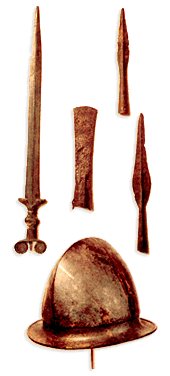The
enigma of Venetic culture - 1000 BC
Recent discoveries and new hypothesis
The period regarded by some historians as a time of greatest advances,
was unequaled by any other period of European history. The Europe
was defined by the settlement of a people called Veneti and the spread of the so-called Urnfield culture. They both
appeared in the 13th century BC and spread over central Europe from
the Baltic Sea down the Apennine Peninsula as far as Sicily. Within
this space significant centres of culture sprang up and thrived,
most of them reaching their peak around 7th century BC, and beginning
to decline by 4th century BC, with the arrival of the Celts.
|
|
The
Urnfield culture was named for its common and distinguishing feature
- the funeral urn and the burial fields. It introduced
into the European arena cremation and the use of urns as the means
of internment of the dead. The custom marked a major change for
most European people of the time in regard to their earthly existence
and life after death.
Beside
the funeral urns, the cultures flourishing during this millennium,
left invaluable archeological evidence of settlement building,
social and economical structures, tool making and ceramic objects.
Outstanding among them, spreading their influence to regions beyond
their designated areas, were the Lausatian culture in central
Europe, Hallstatt culture to the south, the Etruscan culture on
the Apennine Peninsula and the Este culture between the Adriatic
Sea and the Alps.
What else is known about the Veneti? It has been established
that they spoke a common proto-Slavic language, that remained
close to the original Indo-European language. Historians now accept
the term “Venetic” as a linguistic characterization of
the Veneti, including the term “Illyrian”. Place names
containing the word Veneti, Venedi or Wendi, found
throughout central Europe, are supporting evidence of long settlement
of the Venetic people.
|

Adriatic
Veneti territory c. 250 BC
(Map courtesy of Encyclopedia Britanica)
|
 Weapons
of the Hallstatt Culture
Weapons
of the Hallstatt Culture
demonstrate a well developed metal craft |
Slovenian
linguist Matej Bor put forward an interesting hypothesis regarding
the identity of these ancient people. He argued that the original
of Venet (Veneti is the plural form of Venet in Slavic languages)
is actually Slo-venet (Slovenets = Slovenian of male gender).
The word in Old Slavic derives from slovo (word) or sloviti
(to speak). It has been retained till present day as common name
for all the Slavic peoples (Slovan or Sloven), and in the names
of countries - Slovenia, Slovakia, Slavonia, and Slovincia. The
fact that Germans still use the word Wenden (Venedi) when referring
to their Slavic neighbours, confirms the link between the two
names. Apart from this, there are a number of historical references,
where venedi and sclavi are quoted as names used
alternatively for the same people. (It is assumed that the letter
C was inserted into the word slavi,
because Romans did not have the consonantal Sl group in
their language; the same argument can be used for dropping
the letters “slo” and using only “venet”).
Possibly the most significant legacy of this era is the so-called
Venetic script. Almost identical to the Etruscan
script, it was discovered on metal and stone tablets and implements
of the rich Este site, dated about 400 BC. The script itself has
been traced to Phoenicians, and probably came via Etruscans to
the Adriatic Veneti. Till recently both the language and the script
remained an enigma.
Slovenian linguist Matej Bor, specialising in Slavic languages
and Slovenian dialects, finally unlocked the mystery. He started
from the premise that Adriatic Veneti spoke proto-Slovenian. To
his surprise and delight he found in the inscriptions, buried
for more than two millennia, many words still in use in Slovenian
dialects, as well as words used in modern literary Slovenian,
which were unmistakable derivatives. After the breakthrough Bor
made by unlocking the riddle of the so-called alphabet
tablet
ES 24, the Venetic inscriptions could
be read and understood by a trained linguist of similar background.
|
|
The continuity of language spoken by Adriatic Veneti to present
day Slovenian has thus been established. The official historical
view of the arrival of Slovenians in the 6th century AD to their
present territory between the Alps and the Adriatic Sea, must
therefore be reconsidered.
Aleksandra Ceferin, Thezaurus (Melbourne 2000)
From:
Ssavli, Bor, Tomazzic, Veneti-First Builders of European Community
(Vienna 1996)
 
|
|